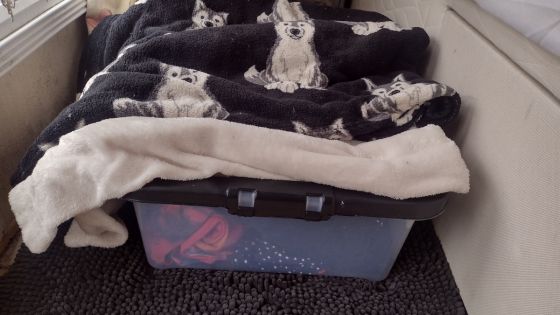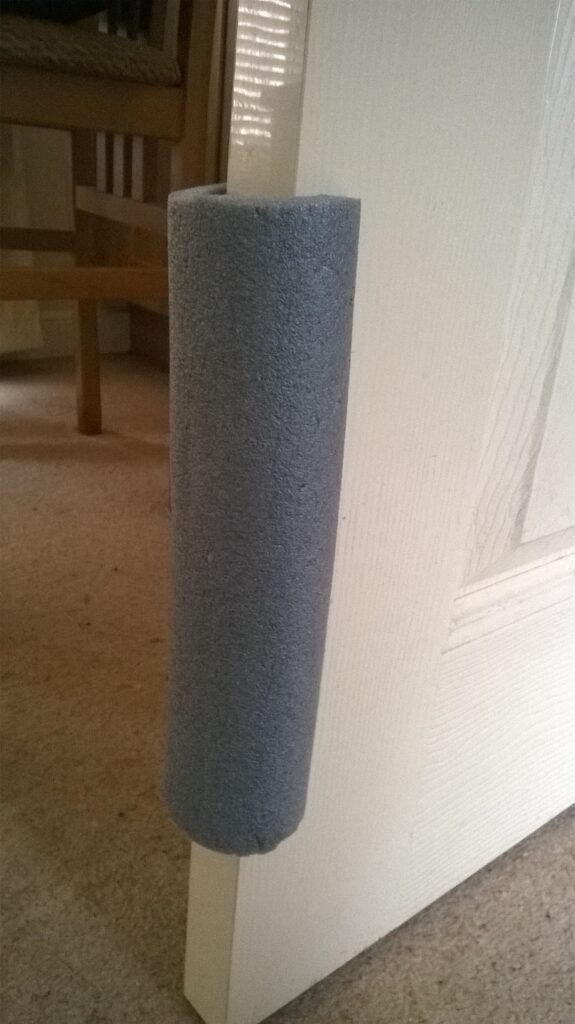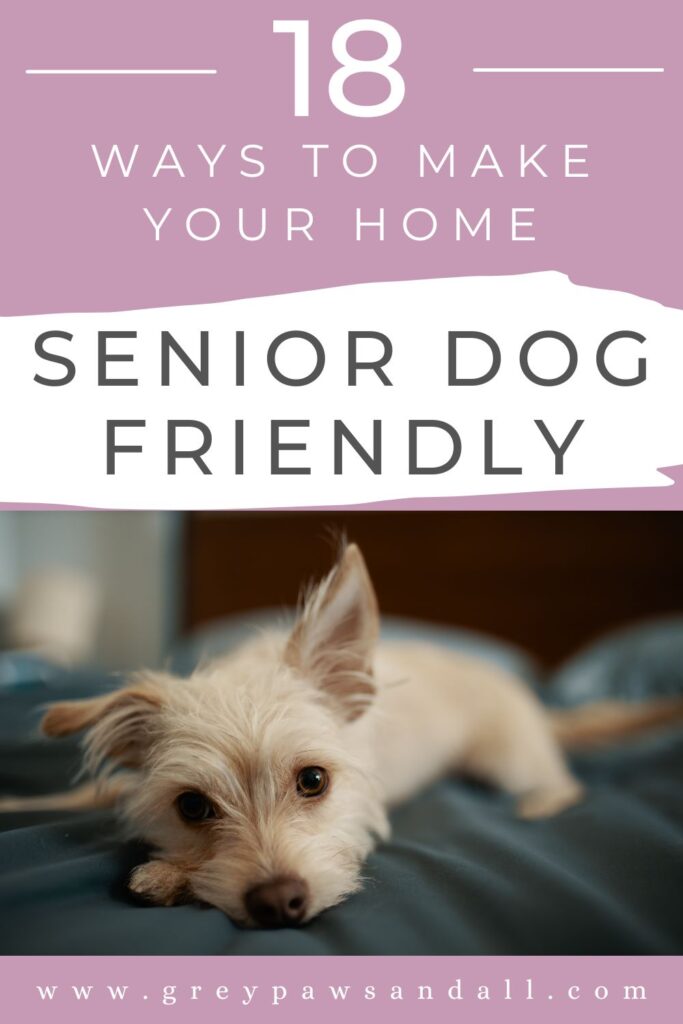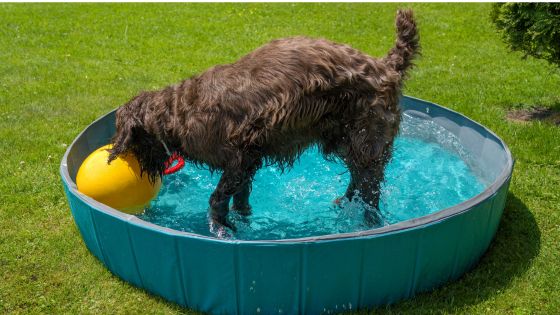One important way to improve your older pup’s quality of life is by making your home senior dog friendly.
Remove tripping hazards, ensure their favorite spots are easily accessible, use mats on slippery floors, keep food and water bowls within reach, get a ramp for the car and try out different style beds.
Comfort Strategies for Aging Pets
I have been sharing my life with senior dogs since 2009, so you could say I’ve learned a thing or two. All of the strategies listed below can help to significantly improve your dog’s quality of life…they certainly worked for my dogs!
Here they are, in no particular order.
18 Tips to Make your Home More Comfortable for Your Older Dog
Remove Tripping Hazards
Whether your dog has mobility issues or just can’t see as well as he used to, be sure to keep all floors clear of clutter. Even the smallest object can be a tripping hazard and cause injury.
Pet Steps and Ramps

Steps
Mobility issues can make it more difficult or even impossible, for your dog to hop onto the couch or bed as easily as he or she used to. Adding steps will still allow access to favorite spots.
I recently bought pet steps for my foster dog Gunther. He was able to jump on and off the bed no problem, but I wanted to make it even easier considering how often he did it! After lots of research I finally settled on the one I wanted, but when it arrived they were tiny and flimsy (yes I checked the measurements!) so I sent them right back.
I took a storage container (see the picture above), put two blankets on top and he used that as a step. It didn’t cost anything because I already had one in the house, it was sturdy enough and the perfect height.
Gunther weighed 28lbs, but I’m not sure how much weight your container could accommodate.
Ramp
A ramp can fit along the side of the bed and is definitely worth a try, but if you don’t have a lot of floor space they may not work on your couch. Some dogs need a very gradual incline and with limited space that may not be possible. It’s helpful for getting in and out of the car, especially if your dog is too heavy to lift.
Be Mindful of the Temperature
Older dogs can feel the cold more than their younger counterparts, even indoors. If you like your home on the cooler side, put a sweater on your dog. My dog Red wore one for months in the house (and I like my house warm!), and she was definitely more comfortable. I had an extra portable heater just in case, and always kept a blanket on every dog bed.
Be sure there are no drafts near your dog’s bed, or where he or she spends the most time.
Elevate Food and Water Bowls
Raising food and water bowls can make it easier for your dog to reach. There are lots of styles to choose from, you’re bound to find one that suits your taste and budget. I went the DIY route, put the water bowl on an upside down casserole dish, and it was the perfect height for my small dogs.
You must be careful of the possibility of bloat, more likely to happen in big and giant breeds. Bloat or Gastric dilatation-volvulus (GDV) happens when a dog’s stomach fills with gas, food or fluid and twists. It’s always an emergency and deadly if left untreated. To learn about this condition and whether or not your dog is at risk, read this article.
Cover Door and Furniture Edges

Whether your dog is experiencing vision problems or confusion, protect him from sharp edges and corners by covering them. I had a bling dog so used pipe insulation slit down the middle on all chair and table legs, as well as the door which you’ll see in the picture here.
Slippery Floors
Muscle wastage, weak hind legs and joint issues can all make walking on slippery floors a challenge. Yoga mats, area rugs, and foam or interlocking rubber mats can all help your dog get a grip.
Set Up a Quiet Area
If your dog has become more anxious, especially when you have visitors, make sure he has a quiet area to relax.
It could be a…
- Closet with the door open
- A room close to where you are so he can still see you
- A crate in a corner with the door open and partially covered
Make sure he has a comfy bed, blanket, favorite toy or two, access to clean, fresh drinking water, and everyone gives him space.
Make a Rug Path
This is a good idea for dogs with fading sight. Different materials are used to create a path, with each texture leading to something different. For example, his water bowl, bed, kitchen… Use a leash or treats to “show” him where everything is, and in time he’ll figure it out.
Beds
Orthopedic beds are always mentioned as the best type for senior dogs. All dogs are different so that may or may not be true in your dog’s case, but it’s worth considering. It distributes weight more evenly, provides extra padding and are easy to get in and out of.
There are plenty of other styles that can satisfy your dog’s needs, but finding the one yours likes may be a case of trial and error.
My dogs always enjoyed a bed with 3 raised sides (make sure they’re sturdy) to lean against, and a low front to get in and out easily, as well as round shaped.
One of my dogs (Red), decided she loved a comforter (duvet), and slept on that for the last couple of years of her life. It provided good support, and flexible enough for her to move and shape the way she wanted.
I suggest putting a few beds around the house so your dog doesn’t have far to go to rest, and put a blanket on each.
If the bed sits directly on a tile floor for example, a blanket or towel underneath should keep your dog warmer.

Heating Mats and Cooling Pads
Both of these are excellent ways to keep your dog comfortable, no matter what the weather is like.
Multiple Water Bowls
It’s not uncommon for our senior dogs to be drinking more than usual. Whether it’s due to a condition like diabetes or medication such as steroids, they need easy access to water. Putting bowls around the house, means he or she won’t have far to walk.
Provide Opportunities for Play and Mental Stimulation
Your dog is out and about getting the physical exercise he needs, but don’t forget to provide him with opportunities for mental stimulation. That could be a training session, playing tug, some homemade “find the treat” games, puzzle toys or a homemade obstacle course. There are so many fun ways to prevent boredom and maybe even help slow the progression of cognitive decline.
Baby Gates
Put them at the top/bottom of stairs, and use them to prevent access to certain rooms or areas that are not safe to be in unsupervised.
Pee Pads
Whether it’s a health issue or medication, senior dogs often have to pee more and don’t always make it out in time. Protect your carpet and your nerves by putting down pee pads.
I covered my entire floor with them when Red developed dementia. It was not the most attractive look, but it was better than coming home to pee stains on my carpet.
Don’t Move Things Around
This piece of advice is particularly relevant for blind dogs, but it’s a good idea anyway. Senior dogs do well with routine and consistency, and things like dementia can add to their confusion. There’s no reason why they have to search for something that was in a certain spot yesterday, but is no longer there today.
Put Nightlights Around the House
While they might be able to see just fine during the day, older dogs may have trouble seeing as well in the dark.
Night lights provide comfort and reassurance, and reduce the risk of your pet bumping into things if they move around.
Backyard
I’m considering the backyard part of your home, so I recommend having a walk around and checking for potential dangers.
Are there any sharp objects such as gardening tools lying around? What about holes in the ground your dog can step into and twist a paw?
Create an Outdoor Sensory Area

I saw this idea of creating a sensory garden on the Yumove website, and I thought it sounded wonderful. It’s a great way to stimulate your dog’s senses and create new experiences.
It doesn’t have to cost much to set up, and you can likely find items around your home or even in dollar stores.
- Bird feeder
- Wind chimes
- Water feature
- A sand pit for digging
- Patio stones
- Dog safe plants such as lavender and mint
- Paddling pool to cool off on hot days. If they need encouragement getting in, throw a ball and see if they follow it!
Conclusion
I hope these tips will help you create a comfortable and stimulating environment, where your old dog can thrive.
Let me know what which ones you’re interested in trying, or if you already have, what did you think? Sharing helps others, so please comment below.
Aging Pet Support
I help senior dog parents struggling with anticipatory grief and quality of life issues by offering practical tips, advice and one on one support. I am also a Certified Pet Loss Specialist, helping you navigate through your pet loss journey.
Click this link to book a FREE 20 minute discovery call, visit my services page to find out more or email hindy@greypawsandall.com if you have any questions.
I’ve been rescuing and caring for senior dogs since 2009. From vision and hearing loss to obesity, dementia, kidney disease, liver issues, cardiac problems, Cushing’s, mobility challenges and more, you could say I’ve dealt with and learned a lot! In addition to my hands on experience, I’ve taken many courses and earned several qualifications to keep learning how to help senior dogs and they include: Senior Dog Enrichment, Understanding Canine Anxiety, Care of the Senior Pet and I’m a Certified Pet Loss Specialist.

